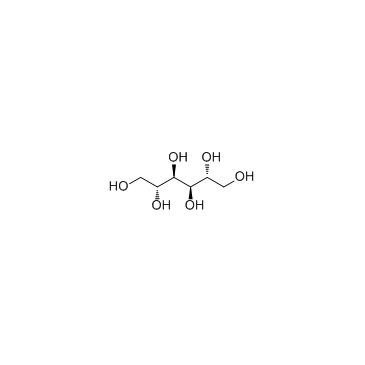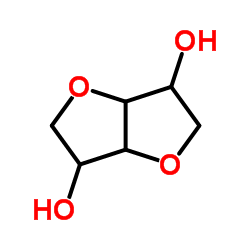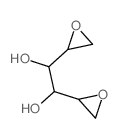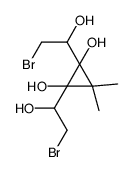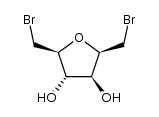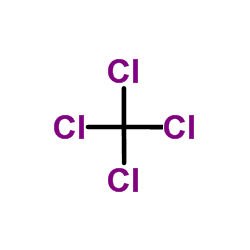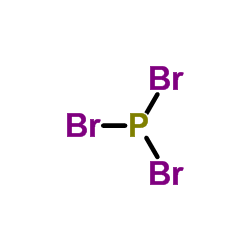1,6-DIBROMO-1,6-DIDEOXY-D-MANNITOL
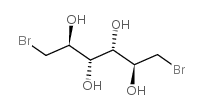
1,6-DIBROMO-1,6-DIDEOXY-D-MANNITOL structure
|
Common Name | 1,6-DIBROMO-1,6-DIDEOXY-D-MANNITOL | ||
|---|---|---|---|---|
| CAS Number | 488-41-5 | Molecular Weight | 307.96500 | |
| Density | 2.117g/cm3 | Boiling Point | 511.2ºC at 760mmHg | |
| Molecular Formula | C6H12Br2O4 | Melting Point | 176-178° | |
| MSDS | N/A | Flash Point | 263ºC | |
Use of 1,6-DIBROMO-1,6-DIDEOXY-D-MANNITOLMitobronitol (Myelobromol; DBM) is a brominated analog of mannitol, also known as an anticancer agent that is classified as an alkylating agent. Mitobronitol has potential for myelosuppression associated with significantly decreased risk for several complications of allogeneic bone marrow transplantation in accelerated chronic granulocytic leukemia[1][2]. |
| Name | 1,6-dibromo-1,6-dideoxy-d-mannitol |
|---|---|
| Synonym | More Synonyms |
| Description | Mitobronitol (Myelobromol; DBM) is a brominated analog of mannitol, also known as an anticancer agent that is classified as an alkylating agent. Mitobronitol has potential for myelosuppression associated with significantly decreased risk for several complications of allogeneic bone marrow transplantation in accelerated chronic granulocytic leukemia[1][2]. |
|---|---|
| Related Catalog | |
| In Vivo | Mitobronitol (850 mg/kg; i.p.; single dose) improves spleen cells to mitogens and enhances thymus regeneration in mice model[2]. Animal Model: Female BALB/c mice (8-10 weeks old)[2] Dosage: 850 mg/kg; 1500 mg/kg (suspended in 5% Tween 80 in saline, 0.5 mL) Administration: Intraperitoneal injection; single dose Result: Showed effect on the in vitro proliferative response of spleen cells to mitogens at 850 mg/kg. Enhanced thymus regeneration and was earlier than control, with the starting resititution time-course of 2 weeks and subtotal resititution time course of 3 weeks under 1500 mg/kg dose. |
| Density | 2.117g/cm3 |
|---|---|
| Boiling Point | 511.2ºC at 760mmHg |
| Melting Point | 176-178° |
| Molecular Formula | C6H12Br2O4 |
| Molecular Weight | 307.96500 |
| Flash Point | 263ºC |
| Exact Mass | 305.91000 |
| PSA | 80.92000 |
| Vapour Pressure | 1.37E-12mmHg at 25°C |
| Index of Refraction | 1.622 |
| InChIKey | VFKZTMPDYBFSTM-UNTFVMJOSA-N |
| SMILES | OC(CBr)C(O)C(O)C(O)CBr |
| Storage condition | −20°C |
CHEMICAL IDENTIFICATION
HEALTH HAZARD DATAACUTE TOXICITY DATA
MUTATION DATA
|
| Hazard Codes | T: Toxic; |
|---|---|
| Risk Phrases | 45-22 |
| Safety Phrases | S22;S45;S53;S36/S37/S39 |
| WGK Germany | 3 |
| RTECS | OP2800000 |
| HS Code | 2905590090 |
|
~% 
1,6-DIBROMO-1,6... CAS#:488-41-5 |
| Literature: Institoris; Horvath; Csanyi Arzneimittel-Forschung, 1967 , vol. 17, # 2 p. 145 - 149 Title/Abstract Full Text View citing articles Show Details Samoilova,O.I. et al. J. Gen. Chem. USSR (Engl. Transl.), 1973 , vol. 43, p. 365 - 369,363 - 366 |
|
~% 
1,6-DIBROMO-1,6... CAS#:488-41-5 |
| Literature: Overend et al. Journal of the Chemical Society, 1948 , p. 2201 |
|
~% 
1,6-DIBROMO-1,6... CAS#:488-41-5 |
| Literature: Fidalgo, Daniela M.; Kolender, Adriana A.; Varela, Oscar Journal of Polymer Science, Part A: Polymer Chemistry, 2013 , vol. 51, # 2 p. 463 - 470 |
|
~% 
1,6-DIBROMO-1,6... CAS#:488-41-5 |
| Literature: Jarman,M.; Ross,W.C.J. Carbohydrate Research, 1969 , vol. 9, p. 139 - 147 |
|
~% 
1,6-DIBROMO-1,6... CAS#:488-41-5
Detail
|
| Literature: Kuszmann, Janos Carbohydrate Research, 1985 , vol. 142, p. 71 - 84 |
|
~% 
1,6-DIBROMO-1,6... CAS#:488-41-5 |
| Literature: Overend et al. Journal of the Chemical Society, 1948 , p. 2201 |
| HS Code | 2905590090 |
|---|---|
| Summary | 2905590090 other halogenated, sulphonated, nitrated or nitrosated derivatives of acyclic alcohols。Supervision conditions:None。VAT:17.0%。Tax rebate rate:9.0%。MFN tariff:5.5%。General tariff:30.0% |
| r54 |
| 1.6-dibromo-1.6-dideoxy-D-mannitol |
| 1,6-dibromo-D-1,6-dideoxy-mannitol |
| 1.6-Dibrom-1.6-didesoxy-D-mannit |
| dibromannit |
| dibromomannitol |
| EINECS 207-676-8 |
| Mielobromol |
| mieobromol |
| myelobromol |
| mitobronitol |
| myebrol |
